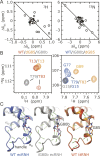An inserted Gly residue fine tunes dynamics between mesophilic and thermophilic ribonucleases H
- PMID: 17088323
- PMCID: PMC2242442
- DOI: 10.1110/ps.062398606
An inserted Gly residue fine tunes dynamics between mesophilic and thermophilic ribonucleases H
Abstract
Dynamic processes are inherent properties of proteins and are crucial for a wide range of biological functions. To address how changes in protein sequence and structure affect dynamic processes, a quantitative comparison of microsecond-to-microsecond time scale conformational changes, measured by solution NMR spectroscopy, within homologous mesophilic and thermophilic ribonuclease H (RNase H) enzymes is presented. Kinetic transitions between the observed major state (high population) and alternate (low population) conformational state(s) of the substrate-binding handle region in RNase H from the mesophile Escherichia coli (ecRNH) and thermophile Thermus thermophilus (ttRNH) occur with similar kinetic exchange rate constants, but the difference in stability between exchanging conformers is smaller in ttRNH compared to ecRNH. The altered thermodynamic equilibrium between kinetically exchanging conformers in the thermophile is recapitulated in ecRNH by the insertion of a Gly residue within a putative hinge between alpha-helices B and C. This Gly insertion is conserved among thermophilic RNases H, and allows the formation of additional intrahelical hydrogen bonds. A Gly residue inserted between alpha-helices B and C appears to relieve unfavorable interactions in the transition state and alternate conformer(s) and represents an important adaptation to adjust conformational changes within RNase H for activity at high temperatures.
Figures






Similar articles
-
Multiple time scale backbone dynamics of homologous thermophilic and mesophilic ribonuclease HI enzymes.J Mol Biol. 2004 Jun 11;339(4):855-71. doi: 10.1016/j.jmb.2004.03.055. J Mol Biol. 2004. PMID: 15165855
-
A thermodynamic comparison of mesophilic and thermophilic ribonucleases H.Biochemistry. 1999 Mar 23;38(12):3831-6. doi: 10.1021/bi982684h. Biochemistry. 1999. PMID: 10090773
-
Structure, stability, and folding of ribonuclease H1 from the moderately thermophilic Chlorobium tepidum: comparison with thermophilic and mesophilic homologues.Biochemistry. 2009 Jun 30;48(25):5890-8. doi: 10.1021/bi900305p. Biochemistry. 2009. PMID: 19408959 Free PMC article.
-
Enzyme dynamics from NMR spectroscopy.Acc Chem Res. 2015 Feb 17;48(2):457-65. doi: 10.1021/ar500340a. Epub 2015 Jan 9. Acc Chem Res. 2015. PMID: 25574774 Free PMC article. Review.
-
Close-range electrostatic interactions in proteins.Chembiochem. 2002 Jul 2;3(7):604-17. doi: 10.1002/1439-7633(20020703)3:7<604::AID-CBIC604>3.0.CO;2-X. Chembiochem. 2002. PMID: 12324994 Review.
Cited by
-
Comparisons of Ribonuclease HI Homologs and Mutants Uncover a Multistate Model for Substrate Recognition.J Am Chem Soc. 2022 Mar 30;144(12):5342-5349. doi: 10.1021/jacs.1c11897. Epub 2022 Mar 21. J Am Chem Soc. 2022. PMID: 35312304 Free PMC article.
-
Thermal adaptation of conformational dynamics in ribonuclease H.PLoS Comput Biol. 2013;9(10):e1003218. doi: 10.1371/journal.pcbi.1003218. Epub 2013 Oct 3. PLoS Comput Biol. 2013. PMID: 24098095 Free PMC article.
-
Dynamics of reassembled thioredoxin studied by magic angle spinning NMR: snapshots from different time scales.J Am Chem Soc. 2009 Sep 30;131(38):13690-702. doi: 10.1021/ja9037802. J Am Chem Soc. 2009. PMID: 19736935 Free PMC article.
-
Interpreting protein structural dynamics from NMR chemical shifts.J Am Chem Soc. 2012 Apr 11;134(14):6365-74. doi: 10.1021/ja300265w. Epub 2012 Mar 28. J Am Chem Soc. 2012. PMID: 22381384 Free PMC article.
-
Thermostability of Enzymes from Molecular Dynamics Simulations.J Chem Theory Comput. 2016 Jun 14;12(6):2489-92. doi: 10.1021/acs.jctc.6b00120. Epub 2016 May 6. J Chem Theory Comput. 2016. PMID: 27123810 Free PMC article.
References
-
- Akke, M. 2002. NMR methods for characterizing microsecond to millisecond dynamics in recognition and catalysis. Curr. Opin. Struct. Biol. 12: 642–647. - PubMed
-
- Akke, M. and Palmer III, A.G. 1996. Monitoring macromolecular motions on microsecond to millisecond time scales by R 1ρ − R 1 constant relaxation time NMR spectroscopy. J. Am. Chem. Soc. 118: 911–912.
-
- Benkovic, S.J. and Hammes-Schiffer, S. 2003. A perspective on enzyme catalysis. Science 301: 1196–1202. - PubMed
-
- Butterwick, J.A., Loria, J.P., Astrof, N.S., Kroenke, C.D., Cole, R., Rance, M., and Palmer III, A.G. 2004. Multiple time scale backbone dynamics of homologous thermophilic and mesophilic ribonuclease HI enzymes. J. Mol. Biol. 339: 855–871. - PubMed
-
- Cavanagh, J., Fairbrother, W.J., Palmer III, A.G., and Skelton, N.J. 1996. Protein NMR spectroscopy: Principles and practice. Academic Press, San Diego, CA.
Publication types
MeSH terms
Substances
Grants and funding
LinkOut - more resources
Full Text Sources
Molecular Biology Databases

